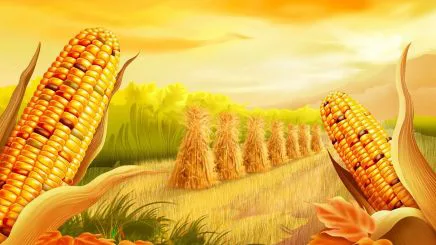
A crop is a plant or animal product that can be grown and harvested extensively for profit or subsistence.[1] Crop may refer either to the harvested parts or to the harvest in a more refined state. Most crops are cultivated in agriculture or aquaculture. A crop may include macroscopic fungus (e.g. mushrooms), or alga (algaculture). Most crops are harvested as food for humans or fodder for livestock. Some crops are gathered from the wild (including intensive gathering, e.g. ginseng). Important non-food crops include horticulture, floriculture and industrial crops. Horticulture crops include plants used for other crops (e.g. fruit trees). Floriculture crops include bedding plants, houseplants, flowering garden and pot plants, cut cultivated greens, and cut flowers. Industrial crops are produced for clothing (fiber crops), biofuel (energy crops, algae fuel), or medicine (medicinal plants).
The importance of a crop varies greatly by region. Globally, the following crops contribute most to human food supply (values of kcal/person/day for 2013 given in parentheses): rice (541 kcal), wheat (527 kcal), sugarcane and other sugar crops (200 kcal), maize (corn) (147 kcal), soybean oil (82 kcal), other vegetables (74 kcal), potatoes (64 kcal), palm oil (52 kcal), cassava (37 kcal), legume pulses (37 kcal), sunflowerseed oil (35 kcal), rape and mustard oil (34 kcal), other fruits, (31 kcal), sorghum (28 kcal), millet (27 kcal), groundnuts (25 kcal), beans (23 kcal), sweet potatoes (22 kcal), bananas (21 kcal), various nuts (16 kcal), soybeans (14 kcal), cottonseed oil (13 kcal), groundnut oil (13 kcal), yams (13 kcal).[2] Note that many of the globally apparently minor crops are regionally very important. For example, in Africa, roots & tubers dominate with 421 kcal/person/day, and sorghum and millet contribute 135 kcal and 90 kcal, respectively. In terms of produced weight, the following crops are the most important ones (global production in thousand metric tonnes)
Maize (/meɪz/ MAYZ; Zea mays subsp. mays, from Spanish: maíz after Taino: mahiz), also known as corn (American English), is a cereal grain first domesticated by indigenous peoples in southern Mexico about 10,000 years ago.The leafy stalk of the plant produces pollen inflorescences and separate ovuliferous inflorescences called ears that yield kernels or seeds, which are fruits.
Maize has become a staple food in many parts of the world, with the total production of maize surpassing that of wheat or rice. However, little of this maize is consumed directly by humans: most is used for corn ethanol, animal feed and other maize products, such as corn starch and corn syrup. The six major types of maize are dent corn, flint corn, pod corn, popcorn, flour corn, and sweet corn. Sugar-rich varieties called sweet corn are usually grown for human consumption as kernels, while field corn varieties are used for animal feed, various corn-based human food uses (including grinding into cornmeal or masa, pressing into corn oil, and fermentation and distillation into alcoholic beverages like bourbon whiskey), and as chemical feedstocks. Maize is also used in making ethanol and other biofuels.
Maize is widely cultivated throughout the world, and a greater weight of maize is produced each year than any other grain. In 2014, total world production was 1.04 billion tonnes. Maize is the most widely grown grain crop throughout the Americas, with 361 million metric tons grown in the United States in 2014. Approximately 40% of the crop—130 million tons—is used for corn ethanol. Genetically modified maize made up 85% of the maize planted in the United States in 2009.
Barley (Hordeum vulgare), a member of the grass family, is a major cereal grain grown in temperate climates globally. It was one of the first cultivated grains, particularly in Eurasia as early as 10,000 years ago. Barley has been used as animal fodder, as a source of fermentable material for beer and certain distilled beverages, and as a component of various health foods. It is used in soups and stews, and in barley bread of various cultures. Barley grains are commonly made into malt in a traditional and ancient method of preparation. In 2017, barley was ranked fourth among grains in quantity produced (149 million tonnes) behind maize, rice and wheat.